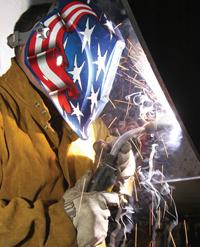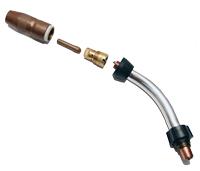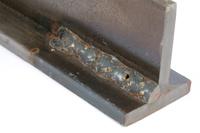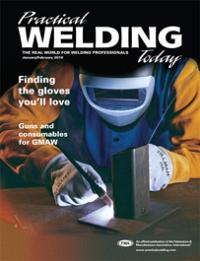Product Manager
- FMA
- The Fabricator
- FABTECH
- Canadian Metalworking
Categories
- Additive Manufacturing
- Aluminum Welding
- Arc Welding
- Assembly and Joining
- Automation and Robotics
- Bending and Forming
- Consumables
- Cutting and Weld Prep
- Electric Vehicles
- En Español
- Finishing
- Hydroforming
- Laser Cutting
- Laser Welding
- Machining
- Manufacturing Software
- Materials Handling
- Metals/Materials
- Oxyfuel Cutting
- Plasma Cutting
- Power Tools
- Punching and Other Holemaking
- Roll Forming
- Safety
- Sawing
- Shearing
- Shop Management
- Testing and Measuring
- Tube and Pipe Fabrication
- Tube and Pipe Production
- Waterjet Cutting
Industry Directory
Webcasts
Podcasts
FAB 40
Advertise
Subscribe
Account Login
Search
GMAW guns and consumables
Separating myth from truth
- By Andy Monk
- January 6, 2010
- Article
- Arc Welding

Figure 1 Familiarizing yourself with the myths and truths about GMAW guns and consumables can have a significant impact on productivity, bottom-line profitability, and welding performance.
Gas metal arc welding (GMAW) guns and consumables sometimes are an afterthought for buyers of welding systems, but considering that they are the most handled piece of welding equipment and are exposed to the most environmental and operator abuse, they can have a significant impact on weld quality, productivity, and operator downtime.
Much of the reason GMAW guns and consumables do not receive their fair share of attention during the equipment selection process arises from common misconceptions about their importance in the welding operation (see Figure 1).
Being aware of four of the most common myths about GMAW guns and consumables and the truths can help you improve productivity, reduce costs, and increase efficiency.
Myth No. 1: Consumables aren't very important to weld quality and performance
The truth: The GMAW gun's consumables—the nozzle, diffuser, and contact tip—provide shielding gas and are the last components of the welding system to come into contact with the welding wire before it enters the weld pool (see Figure 2). As such, consumables can have a big impact on weld quality and productivity, and selecting high-quality ones and properly maintaining them are essential.
Consumables differ considerably by brand in terms of both design and material quality. Good-quality consumables provide a large contact area between the diffuser and the contact tip and have a secure locking mechanism to keep the contact tip and diffuser fitting tightly together. These features mitigate weld quality problems related to inconsistent electrical transfer, as well as the frequency of contact tip burnbacks, a noteworthy source of downtime.
High-quality consumables also provide smoother, less turbulent shielding gas coverage, which in turn reduces the potential for porosity and other defects that result from air coming into contact with the weld pool (see Figure 3).
Equally important in selecting the right consumables is maintaining them properly. Good-quality consumables are better equipped to resist buildup. However, no consumables can completely avoid spatter buildup. Use needle nose pliers, a nozzle reamer, or other device to dislodge spatter buildup to prevent interruptions in shielding gas flow and corresponding weld defects. You should inspect the nozzle for spatter buildup several times a day and clean it out as needed.
In addition to checking and cleaning out spatter, you should check to ensure the contact tip sits tightly in the diffuser and that the inside bore has not become excessively worn. Nonthreaded contact tips can be rotated in place to provide a new contact surface with the welding wire when it becomes worn on one side. Some threaded contact tips allow you to rotate them 180 degrees to extend tip life.
Myth No. 2: Preventive gun and consumables maintenance is a waste of valuable time that could be better spent on production.
The truth: Compared to the time spent reworking bad welds and replacing severely damaged components, spending a few minutes each day inspecting and maintaining the GMAW gun and consumables is a bargain.
Identifying potential problems early is essential to avoid the much higher costs that can result from allowing a minor problem to grow into a major headache. For example, a damaged O-ring on the feeder connection is very easy and inexpensive to repair, but left unchecked, it can create very costly weld porosity.

Figure 2 The GMAW gun's diffuser, contact tip, and nozzle serve critical functions in ensuring proper shielding gas coverage and good electrical transfer to the welding wire. You should check these several times a day to ensure the components fit tightly together and that the nozzle isn't obstructed by spatter.
Because GMAW guns have few moving parts and are relatively simple to inspect, you should check the connections between the wire feeder, the cable, the gun, the neck, and the consumables on a daily basis to ensure they are tight and undamaged. A loose or damaged fitting can create resistive heat buildup, poor weld quality, and shortened component life.
Consumables should be checked several times throughout the day to ensure the inside bore of the contact tip is not excessively worn down and that the shielding gas flow is not obstructed by spatter in the nozzle. The liner is one of the most difficult GMAW gun components to inspect, so it's often best to use compressed air to clean out any metal shavings and debris during each wire changeover.
Routine inspection and maintenance should take up no more than 10 to 15 minutes per day, which averages out to $1,300 per year in downtime. By contrast, reworking or scrapping bad welds can take up several hours each time it happens. If an operator spends four hours per week fixing weld defects caused by improperly maintained equipment, that downtime can cost a company roughly $6,240 per year. Even more importantly, it can cause the company to fall behind on product deadlines and threaten their client relationships.
Myth No. 3: It's always better to err on the safe side and overmatch the gun amperage to the application.
The truth: Many job shops make the mistake of using a 400-amp GMAW gun when their applications require 375 amps. The problem with overmatching the gun amperage to the application is that most operators weld for only 30 to 50 percent of the time, which means that they can easily get by with a 300-amp gun and rarely, if ever, exceed its duty cycle in an application requiring 375 amps.
A 400-amp gun could certainly handle the demands of the application, but it is also heavier and bulkier, leading to earlier operator fatigue and reduced productivity.
To achieve maximum operator efficiency, companies need to analyze their specific welding demands and purchase a gun that is as small and light as possible while still meeting the amperage requirements of the application.
Another factor you should consider is the GMAW gun's weight and size. One gun brand rated to 400 amps could be considerably heavier and bulkier than a similarly rated gun from another company.
Not all gun manufacturers label and market their guns to a 100 percent duty cycle rating, so be sure to verify that you are making an apples-to-apples comparison when evaluating GMAW guns from different manufacturers. For example, company A's 300-amp GMAW gun might be able to weld at 300 amps at 100 percent duty cycle, but company B might also make a gun that it says is a 300-amp GMAW gun but is rated to 300 amps only at 40 percent duty cycle. The amperage-to-duty-cycle ratings are usually available in the specification sheets from most major GMAW gun manufacturers, so check there to make sure the gun is able to handle your applications.
Myth No. 4: The GMAW gun liner does not have a significant effect on welding performance.
The truth: A properly functioning GMAW gun liner, regardless of brand, does not have a significant effect on welding performance. When a liner is not functioning properly, however, its importance in the welding operation becomes clear.
The liner's main function is to provide unobstructed passage for the welding wire to travel from the feeder, through the cable and gun, into the consumables. It's a very simple role within the welding operation, yet a number of problems can arise in the liner that can lead to weld defects and lost productivity.

Figure 3 Spatter buildup, poor electrical conductivity, or a clogged liner can cause porosity. High-quality guns and consumables can reduce the occurrence of porosity and the associated costs of remedying the problem.
A quality liner provides a consistent inside diameter through which the welding wire travels, thereby reducing friction and extending the service life of the liner and the time that it takes for wire filings to clog the liner, one of the most frequent sources of liner-related downtime. The liner is most susceptible to this problem when the cable is bent too far and increases the friction between the wire and liner.
Other causes of clogged liners include using an incorrect liner size and trimming it improperly. In both cases, the liner can shave metal filings from the welding wire and become clogged, leading to erratic wire feeding, poor weld quality, and birdnests. Because the copper stranding in GMAW gun cables is wound in a helix pattern, the cable shrinks when it is twisted. Trimming a new liner to the length of a twisted cable can cause the liner to be too short when the cable is straightened out, leaving an empty space in which the welding wire can become lodged and birdnest.
Additional downtime can be saved by using an easily replaced partial liner that installs from the front of the gun and goes only through the gun's neck. The most wire-to-liner friction occurs in the neck, so that part of the liner is usually the first to wear out. Some companies offer partial liners that can be changed in as little as two minutes, rather than 20 minutes to replace the entire liner.
In times of economic uncertainty, it's understandable that companies would seek to reduce their production costs by purchasing less expensive equipment. However, the true costs of purchasing low-quality equipment—lost productivity, reduced weld quality, increased scrap, and excessive downtime—can far exceed the higher price of higher-quality GMAW guns and consumables.
About the Author
Andy Monk
449 W. Corning Road P.O. Box 667
Beecher, IL 60401
708-946-6726
About the Publication
Related Companies
subscribe now

The Welder, formerly known as Practical Welding Today, is a showcase of the real people who make the products we use and work with every day. This magazine has served the welding community in North America well for more than 20 years.
start your free subscription- Stay connected from anywhere

Easily access valuable industry resources now with full access to the digital edition of The Fabricator.

Easily access valuable industry resources now with full access to the digital edition of The Welder.

Easily access valuable industry resources now with full access to the digital edition of The Tube and Pipe Journal.
- Podcasting
- Podcast:
- The Fabricator Podcast
- Published:
- 04/16/2024
- Running Time:
- 63:29
In this episode of The Fabricator Podcast, Caleb Chamberlain, co-founder and CEO of OSH Cut, discusses his company’s...
- Industry Events
16th Annual Safety Conference
- April 30 - May 1, 2024
- Elgin,
Pipe and Tube Conference
- May 21 - 22, 2024
- Omaha, NE
World-Class Roll Forming Workshop
- June 5 - 6, 2024
- Louisville, KY
Advanced Laser Application Workshop
- June 25 - 27, 2024
- Novi, MI































